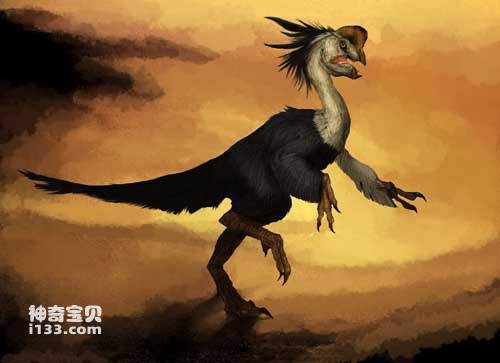Chinese name: Oviraptorosaurus
Latin name: Oviraptor
Age of survival: Late Cretaceous
Fossil origin: Mongolia
Physical characteristics: 1.8~2.5 meters long
Diet: carnivore
Type: Theropod
Definition: egg thief

In 1920, the Third Central Asia Expedition, led by the Museum of Natural History in New York, shocked the world with its successful excavations in Inner Mongolia, China and the Gobi Desert in southern Mongolia.
The expedition discovered the first batch of dinosaur eggs in history and a large number of new species of dinosaurs. When cleaning the egg fossil, the expedition technician Ousen found scattered rib fragments next to the egg, as well as some white bones, which were part of the formed joints, limbs and leg bones. The expedition continued to dig deeper into the red rock, gradually revealing larger bones and even a broken skull. This skeleton is very strange. It is a dinosaur unknown to humans and looks like a bird. During the study, renowned paleontologist Osborne, then director of the Department of Vertebrate Paleontology at the American Museum of Natural History, believed that it apparently died during a daring theft. It is conceivable that when Protoceratops returned to its nest, it found that Oviraptorosaurus was trying to steal its eggs. In anger, Protoceratops crushed the thief's head under his feet. Therefore, like an eternal curse, the fossil was named "Oviraptor", which means "egg thief" in Latin.
Oviraptorosaurus is 1.8 to 2.5 meters long and weighs 25 to 35 kilograms. It has 3 fingers on each hand with sharp and curved claws. The first finger is much shorter than the other two fingers. This finger is like a thumb and can be bent in an arc towards the other two fingers to grasp the prey tightly. Oviraptorosaurus can run at high speeds with its two long hind legs and three strong claws on its legs. Oviraptorosaurus had no teeth in its mouth, but its beak was so powerful that it could break bones. It is shaped like a turkey and has a long tail.
In most pictures and books about dinosaurs, Oviraptorosaurus is often depicted as using its beak to crack eggshells, steal eggs and suck them. However, in 1993, more Oviraptor fossils were found at the same location with similar eggs, one of which contained the tiny bones of an Oviraptor embryo. Dr. Mark Rowell of the American Museum of Natural History It is believed that the Oviraptorosaurus was definitely not killed for stealing eggs, but to protect its own eggs. It used its long claws to protect the young lives when danger came. He also believed that the diet of Oviraptorosaurus was mainly mussels and clams in fresh water, because more Oviraptorosaurs were found in sediments at the edge of lakes. At this point, the 70-year injustice was finally redressed, but according to the nomenclature, the curse of the name will continue. However, from now on, the image of the oviraptor in our hearts will change. It is no longer an "egg thief", but a dutiful parent. .
animal tags: Oviraptor
We created this article in conjunction with AI technology, then made sure it was fact-checked and edited by a Animals Top editor.